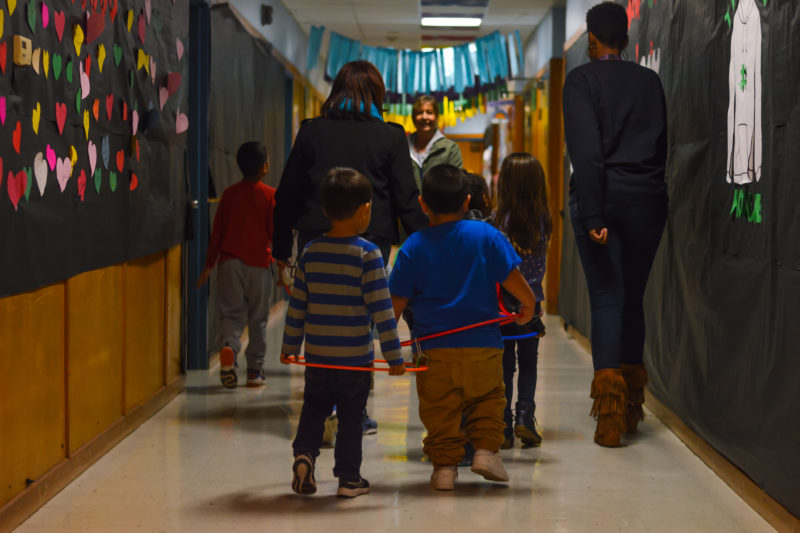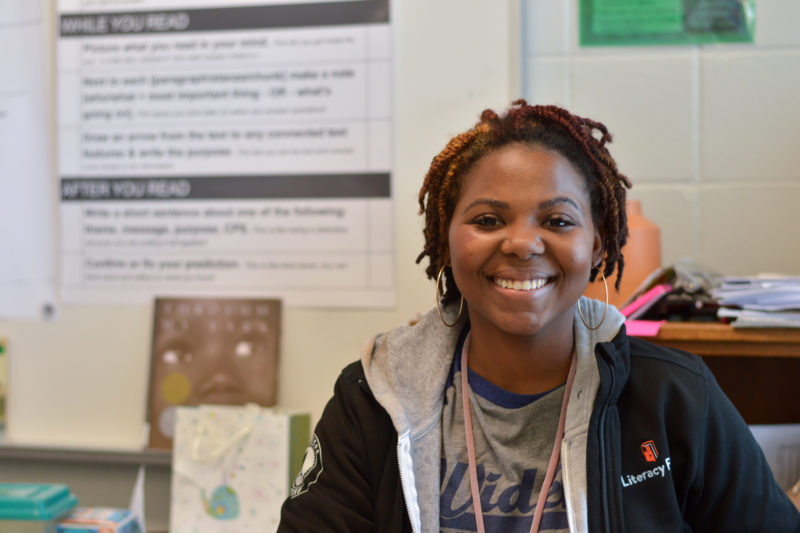Austin ISD’s Rising STAAR: Widén Elementary Aims to Maintain Test Score Improvement
By Aimée Knight
Reporting Texas

Widén Elementary had the largest improvement in state accountability ratings from 2018 to 2019 in AISD, from an “F” to a “B.” Iris Bilich/Reporting Texas
In 2018, the Texas Education Agency gave Austin’s Widén Elementary School an “F” in the state’s annual accountability ratings. In 2019, the school earned a “B” – the largest improvement of any elementary school in the Austin Independent School District.
In Texas, schools are rated primarily using the results of the standardized STAAR test. The last decade has seen a pitched national debate about the role standardized tests should play in rating schools. Critics have long argued standardized test scores often correlate with socioeconomic status and parental income; students from affluent families tend to perform better than students who are not.
The turnaround at Widén — which serves 450 students, 96% of whom are economically-disadvantaged according to The Texas Education Agency — offers lessons on how to approach improvement in a comprehensive way, some educational professionals say. “It seems like all the pieces are fitting together really well at Widén,” said Suki Steinhauser, CEO of Communities in Schools of Central Texas, a nonprofit that places full-time social workers in schools to mentor students.
Not everyone agrees on the value of chasing such goals. Critics contend testing is an inaccurate way of measuring a student’s academic abilities, and time spent learning how to take a test is different from learning – and retaining – the test’s contents. Widén, however, has created and is sticking to a model of improvement working to comply with the state’s expectations.
(In March, when the coronavirus pandemic prompted Governor Greg Abbott to close Texas schools, state educational authorities canceled standardized testing for this academic year, but STAAR policy remains the state’s metric for campus score generation.)
“We had a reputation for being a low-performing school with a lot of discipline,” Jennifer Pace, principal at Widén since 2017, said. “Telling everybody we’re going to change that story and we’re going to be a part of a journey …. There’s a lot of power in just believing something’s possible.”

Jennifer Pace, principal of Widén Elementary, stands near the entrance of the school. Iris Bilich/Reporting Texas
Widén is located in Austin’s Dove Springs neighborhood on the southeast edge of the city. Almost 90% of students are Hispanic and about 7% are African American. Pace credits the school’s test score improvement to hiring a robust leadership team, a creative approach to test preparation and a shift in campus culture.
Pace says she reallocated the school’s 2018 budget to hire a community engagement facilitator, a teaching mentor and two teaching assistants.
“First and foremost I think about spending that budget on the staffing piece,” Pace said, “on the humans that we need to run what it is we’re running.” Those hires allowed the leadership team — an assistant principal, a counselor, a dyslexia teacher, and math, reading and behavior specialists — to assist teachers with lesson planning. Pace calls the setup an “all hands on deck” strategy.
Each member of the leadership team assigned themselves to one of the seven grade levels and helped teachers prepare lessons on a weekly basis. “It was a lot of work and it’s labor intensive,” Pace said, but the involvement created consistency across grade levels.
In addition to involving the leadership team in lesson planning, in the fall of 2018, students began creating bar graphs marking their scores on monthly literacy and vocabulary tests, giving them a hand in tracking their own progress. After each test, teachers sat down one-on-one with students and discussed scores and goals.
“I’d help monitor in the cafeteria at lunch and they’d be bursting to look at their scores,” Pace said. In her 21 years of teaching, she hadn’t seen the approach used elsewhere. “It was really different to get kids excited about that,” Pace said.
Because the STAAR test format and language are unfamiliar to many of Widén’s students, Pace says her teachers allot classroom time to test preparation, but not to the exclusion of other forms of learning. “You can’t do test prep Monday through Friday and not expect to see (bad) behavior all over the place,” she said.
Bilyesia Cooper, a third-grade English as a second language teacher at Widén, says she struck this balance by alternating days of creative lessons and test preparation. She integrates “hot-seating,” in which students act as a character from a text and field questions from their classmates. She also uses town-hall forums, where students practice defending different points of view in a debate setting, on Mondays and Tuesdays. STAAR test preparation takes place on Wednesdays and Thursdays.
“We do testing every Friday because we’re trying to build their stamina,” Cooper said. There is an element of endurance necessary, she says, because the tests are 30 pages long with about 60 questions.
When Pace became principal, she found student and staff morale extremely low, so she implemented a campus-wide positive behavior recognition program. “It’s a lot of cheerleading,” Pace said. “A lot of smiles, a lot of love.”
“It’s a very celebratory school,” Cooper said. For example, if students have perfect attendance for a month, they qualify for a raffle during regular school assemblies, where prizes have included gel pens, snacks, fidget toys and, on one occasion, a bicycle donated by Widén supporters.

Teacher Bilyesia Cooper sits at her desk while her students unwind after taking several tests. Iris Bilich/Reporting Texas
Pace says the school has also implemented a model of classroom management called Responsive Classroom. The approach marries social and emotional learning techniques to discipline interventions.
Danielle Bryant, Widén’s community school facilitator, who organizes the school’s outreach to the surrounding community, says the foundation of a responsive classroom is building relationships with students rather than focusing on punishment as a behavioral management tool. The program incorporates mindfulness with class community-building. Each day begins with a morning meeting, where students have a class greeting, an opportunity to share successes, a group activity like a call-and-response game and a positive morning message.
“It was a several-year-long process of changing these existing structures so that kids are expecting a morning meeting every day,” Bryant said. “We need to hold them to high expectations … but high expectations and rigor also need to be met with a love for who our students are as humans and an appreciation for everything that they bring.”
Suki Steinhauser of Communities in Schools recognizes Widén’s progress is the result of a multi-layered approach. “It’s that thoughtful and comprehensive approach to making sure kids who face obstacles to their education are helping to get those obstacles out of the way,” she said.
Steinhauser says changing a school’s climate is essential to improving test scores. A 2016 study in the Review of Education Research looked at 78 school systems in the U.S. dating back to 2000 and found substantial evidence that a positive school climate contributes to academic achievement, especially for students from challenged socioeconomic backgrounds.
Julian Vasquez Heilig, dean of the University of Kentucky’s College of Education, says that while elementary schools like Widén have comparatively better odds of achieving a turnaround than middle or high schools, using tests to measure student success— as Texas does— is a dubious practice because it correlates socioeconomic status with scores.
“Tests are arbitrary and they’re political, and they’re not very good for measuring what we think they measure,” Vasquez Heilig said. When schools focus on teaching students how to take a test, he argued, it has consequences later in their educational career “because taking a test is not necessarily learning. Whether it’s creative or not creative, we should be asking ‘Is test prep the kind of education we want to give our children?’”
“Wealthy schools do not test prep,” Vasquez Heilig said. “That should tell us something. The wealthy would never allow that to happen to their children.”
Pace recognizes how tests contain intrinsic bias because questions include information and reference experiences a lot of economically disadvantaged kids can’t relate to.
“So many of our kiddos here have not been out of their own neighborhoods,” she said. “They haven’t been to the beach. They only go to restaurants in the vicinity. Not that they can’t read about things and learn about things that are unfamiliar to them, but there is still that bias.”
In the wake of pandemic-related school closures, Pace says her biggest challenge right now is making the transition to distance learning, as much of the school community has limited access to the internet and laptop devices. “The district is currently working on getting hotspots and Chromebooks to third- through fifth-grade families,” she said, “and we’re waiting to see if the district will be able to provide any type of technology for Pre-K through second grade.”
Looking forward to COVID-closed schools reopening in the fall, Pace says she and her team at Widén will continue working toward what the state expects of them —to improve STAAR test scores, among other ways of monitoring student growth. “It hasn’t been easy, it’s tiring work,” she said. “But I think when you see that it’s possible, it’s a game-changer … it puts wind in your sails … now that we’ve got a B let’s go for an A.”